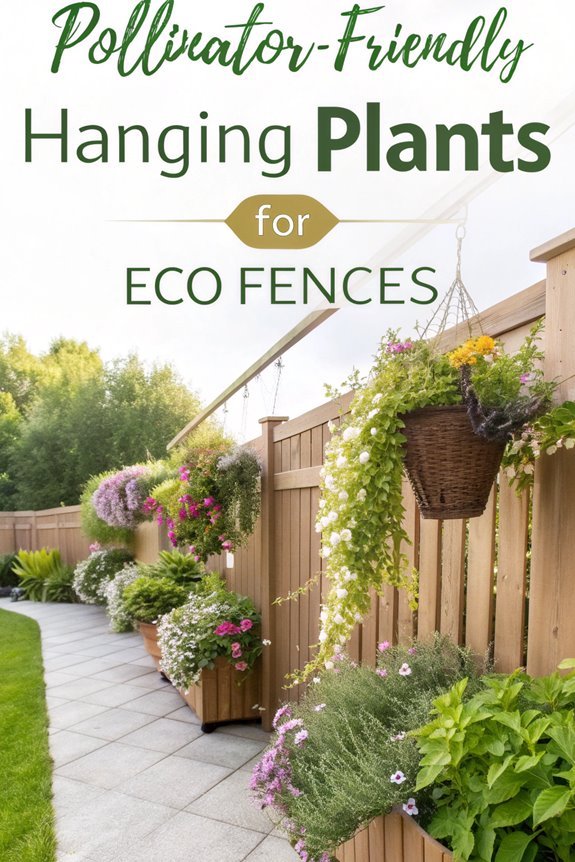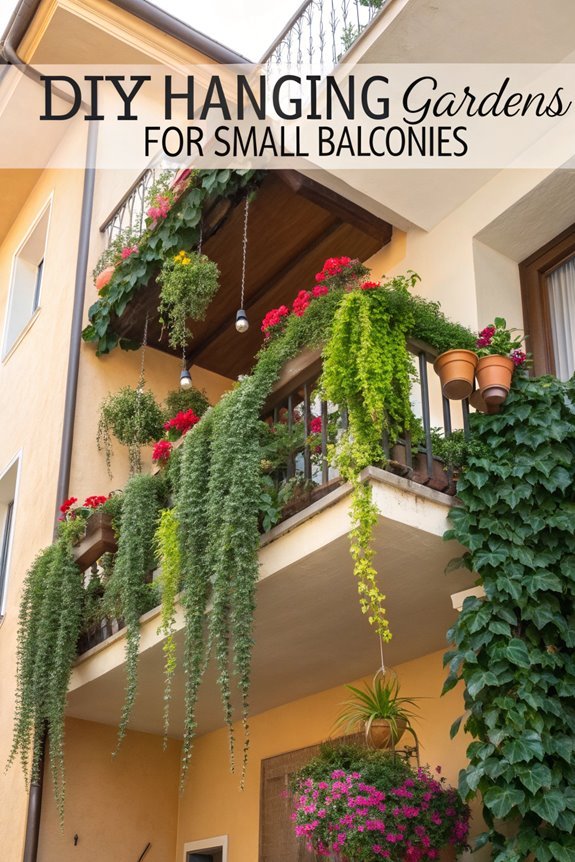15 Tips for Keeping Indoor Water Plants Healthy
Indoor water plants thrive best when you understand their unique needs. With some basic tips, both seasoned plant parents and beginners can ensure their plants flourish.
From selecting the right water to monitoring light requirements, maintaining healthy indoor plants is simpler than it seems. Dive into the essentials for keeping your leafy companions vibrant!
Choose the Right Water Type
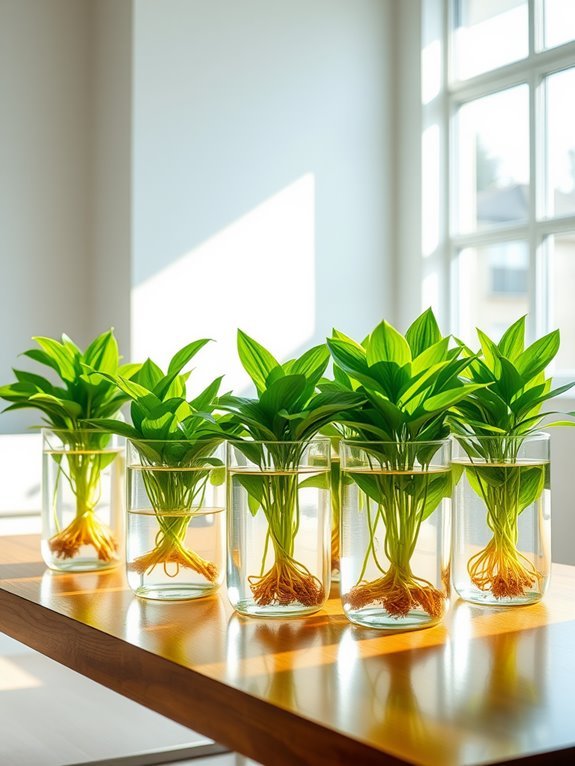
When it comes to keeping your indoor water plants happy and thriving, choosing the right water type is like picking the perfect outfit for a big event—it can make all the difference!
You wouldn’t wear flip-flops to a fancy gala, right? Similarly, your plants need the right H2O. Tap water’s often loaded with chemicals that can turn your leafy friends into sulky divas.
Instead, consider using distilled or rainwater; they’re like a spa day for plants! Just remember, each plant has its own preferences, so check their needs and keep them sipping the good stuff.
Your plants will thank you with vibrant growth!
Ensure Proper Drainage
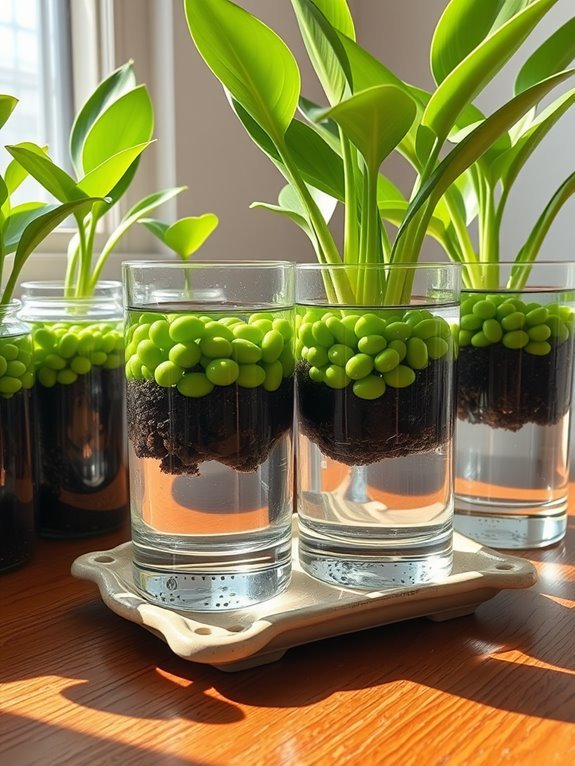
To keep your indoor water plants in tip-top shape, ensuring proper drainage is essential—just like making sure your car has enough oil to run smoothly!
Standing water can lead to root rot, and trust me, your plants won’t appreciate that. Use pots with drainage holes to let excess water escape, and consider adding a layer of gravel at the bottom for extra help.
If you’re feeling fancy, you might even try self-watering pots. Just remember, your plants love a good drink, but they don’t want to swim!
Monitor Light Conditions

After you’ve got your drainage sorted, it’s time to shine a light on another key factor in keeping your indoor water plants happy—monitoring their light conditions.
Different plants have different light needs, so pay attention! Some love bright, direct sunlight, while others prefer a cozy, shaded spot. You might say they’re a bit picky!
Check your plants daily; if they’re stretching towards the light, it’s a sign they want more. If their leaves start turning yellow, it could mean they’re getting too much.
It’s all about finding that perfect balance—like a dance, but with plants instead of partners!
Maintain Optimal Temperature
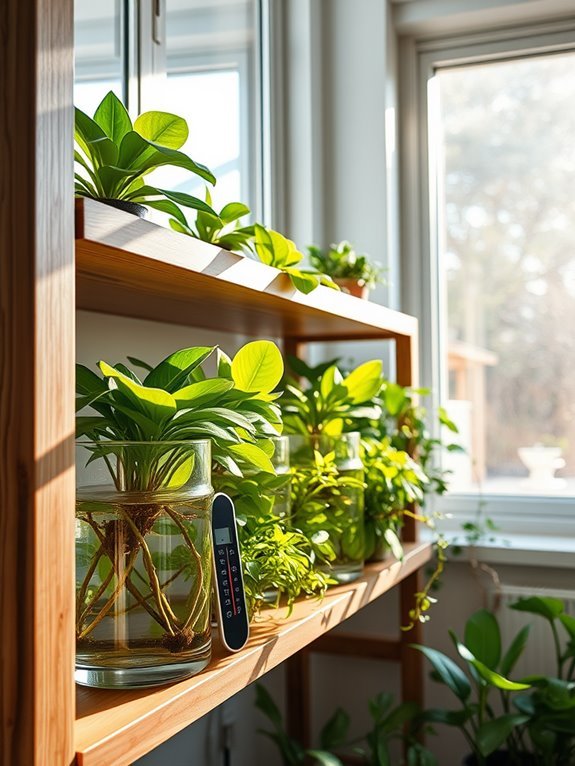
While you might think that keeping your indoor water plants thriving is all about water and light, don’t underestimate the importance of maintaining an ideal temperature!
These green beauties love a cozy environment, usually between 65°F and 75°F. Too hot or too cold, and they’ll start to sulk, just like you’d after a chilly shower!
Keep them away from drafts, heaters, or air conditioners that can cause temperature swings. If you notice droopy leaves or stunted growth, it might be time to check the thermostat.
Use Fertilizer Wisely
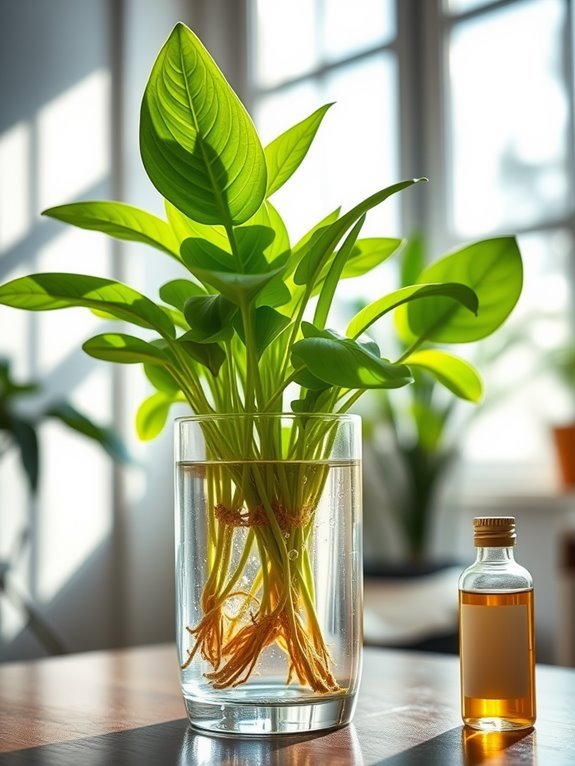
Using fertilizer wisely can be a game-changer for your indoor water plants, especially since they rely on you to give them the nutrients they need to flourish!
Start by choosing a balanced, water-soluble fertilizer—think of it as a tasty smoothie for your plants. Dilute it to avoid overwhelming them, and apply it during the growing season.
Don’t go overboard; just like you wouldn’t gulp down a gallon of smoothie, your plants can’t handle too much either! Keep an eye on their growth, and if they’re thriving, you’re doing great.
Keep an Eye on Humidity Levels
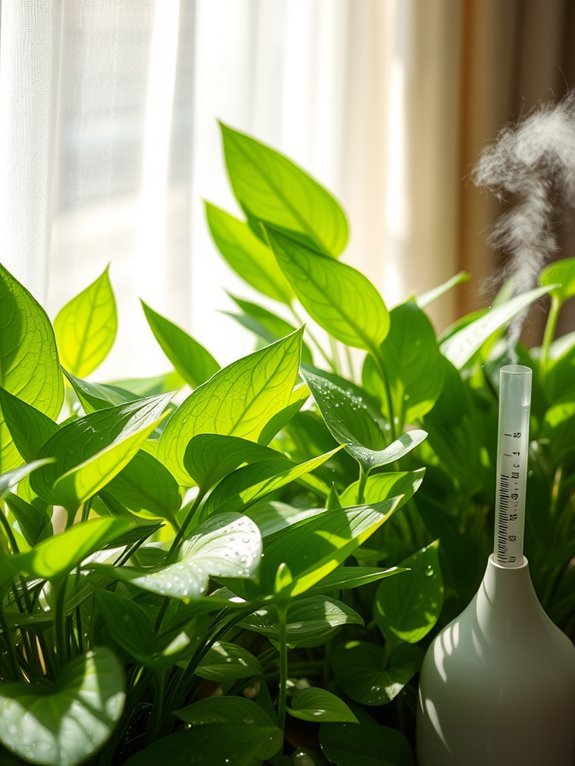
Humidity plays an essential role in keeping your indoor water plants happy and healthy, so don’t let it slip your mind!
These green beauties thrive in environments where humidity levels are just right. If your home’s air feels drier than a desert, your plants might start to sulk.
Consider using a humidifier to boost moisture or placing a tray of water near them—bonus points for adding pebbles for flair! You can even mist them occasionally, but avoid making them feel like they’re in a rainstorm.
Prune Dead or Yellowing Leaves
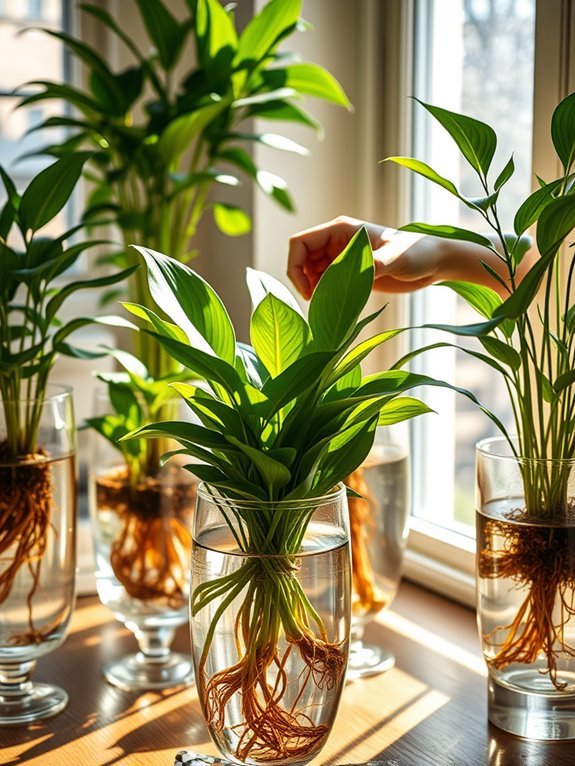
Snip away those dead or yellowing leaves to give your indoor water plants a fresh start!
It’s like giving them a little haircut; your plants will appreciate it! By pruning these leaves, you not only improve their appearance but also encourage healthier growth.
Grab a pair of clean scissors or pruning shears, and carefully cut just above the base of the leaf.
Don’t worry; your plants won’t hold a grudge! Regularly checking for and removing any unsightly foliage keeps your water plants looking vibrant and happy.
Plus, who wouldn’t want plants that look as fabulous as they feel?
Happy pruning!
Check for Pests Regularly
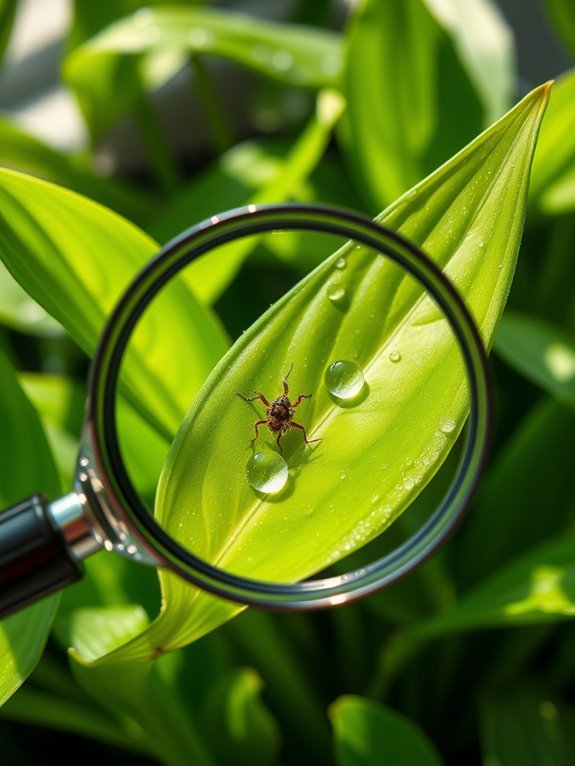
After giving your indoor water plants a little haircut, it’s time to shift your focus and keep an eye out for any pesky intruders.
Pests can sneak in when you least expect it, so don’t forget to play detective! Regularly check the leaves, stems, and roots for any signs of trouble.
Here’s what to look for:
- Tiny webs or spots that shouldn’t be there
- Little bugs scuttling around (yikes!)
- Discoloration or wilting that seems off
Change Water Regularly
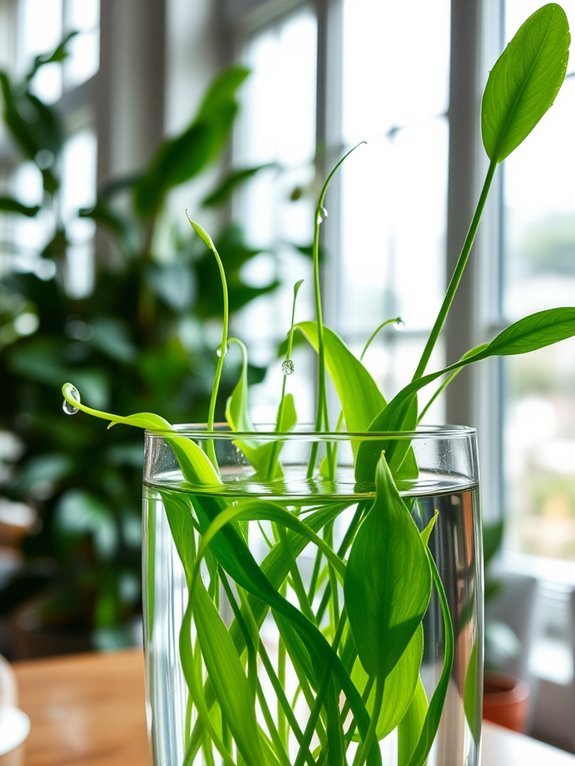
To keep your indoor water plants thriving, it’s essential to make changing the water a regular part of your care routine.
Dirty water can lead to unhappy plants, and nobody wants that! Aim to change the water every week or two, depending on the plant and the environment.
This simple step helps prevent algae build-up and keeps your plants lively and healthy. Plus, it’s a great excuse to check in on your green friends!
Select Suitable Containers
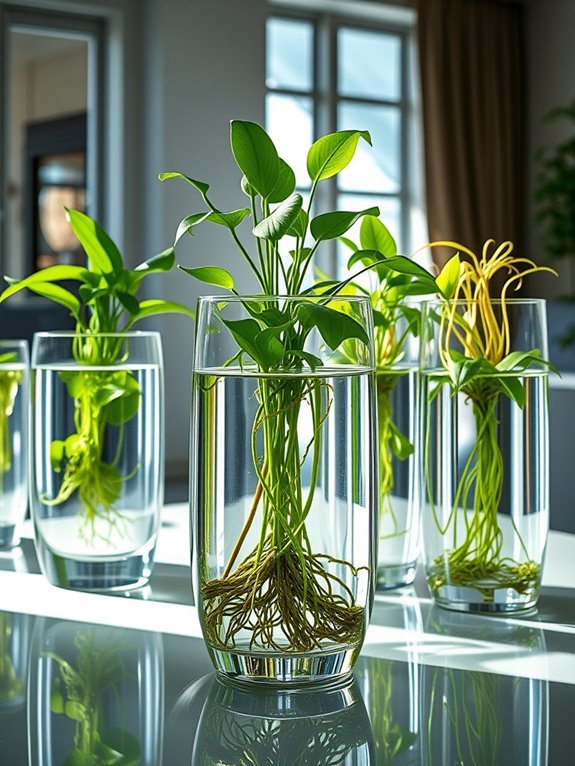
Choosing the right container for your indoor water plants is just as important as changing their water.
The container not only holds your plants but also affects their health and growth. You want something that looks good but also provides proper drainage and aeration.
Here are a few tips to help you select the perfect pot:
- Material Matters: Go for glass or ceramic, as they’re stylish and durable.
- Size Counts: Make sure it’s big enough for roots to thrive, but not so big your plant feels lost.
- Consider Weight: Choose lighter options for easy moving, like a plant on a mission!
Happy planting!
Group Plants for Mutual Benefits
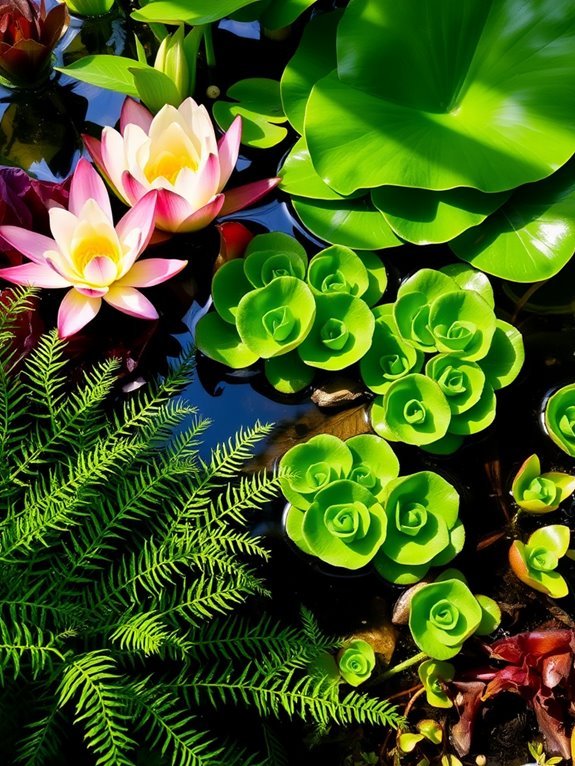
Grouping your indoor water plants isn’t just a smart idea; it can actually boost their health and happiness! When you cluster plants together, they create a mini-ecosystem, sharing humidity and creating a cozy environment.
Plus, certain plants can even help each other out, like those that thrive in similar light conditions. You’ll notice they’re happier, and you might even find it easier to care for them!
Just imagine your plants throwing a little party—sharing nutrients, exchanging oxygen, and soaking up the good vibes. So, gather your green friends and let them enjoy their plant-tastic social life! It’s a win-win!
Repot When Necessary

When your indoor water plants start to look a little cramped or their roots are peeking out of the pot like they’re trying to escape, it’s time to repot! This simple task can revive your plants and give them the space they crave.
Choose a pot that’s one size larger and fill it with fresh potting mix.
- Make sure there’s good drainage for those thirsty roots.
- Water your plants well after repotting to help them settle in.
- Give them some time to adjust—don’t worry if they look a little droopy at first!
Happy repotting!
Avoid Overcrowding Plants
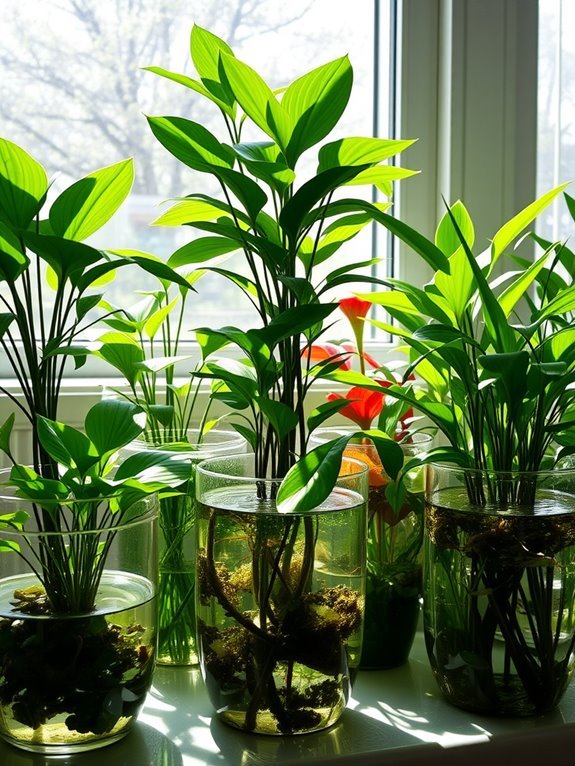
To keep your indoor water plants thriving, it’s crucial to avoid overcrowding them in their pots.
Think of your plants as guests at a party—too many in one space, and they’ll start fighting for attention! When you pack them too closely, they compete for nutrients, light, and air, which can lead to stress and poor growth.
Give each plant room to breathe, spread its leaves, and soak up all that delicious water. If you notice overcrowding, don’t hesitate to repot or share some cuttings with friends.
Happy plants equal happy you, so let’s keep that plant party fun and lively!
Educate Yourself on Plant Species
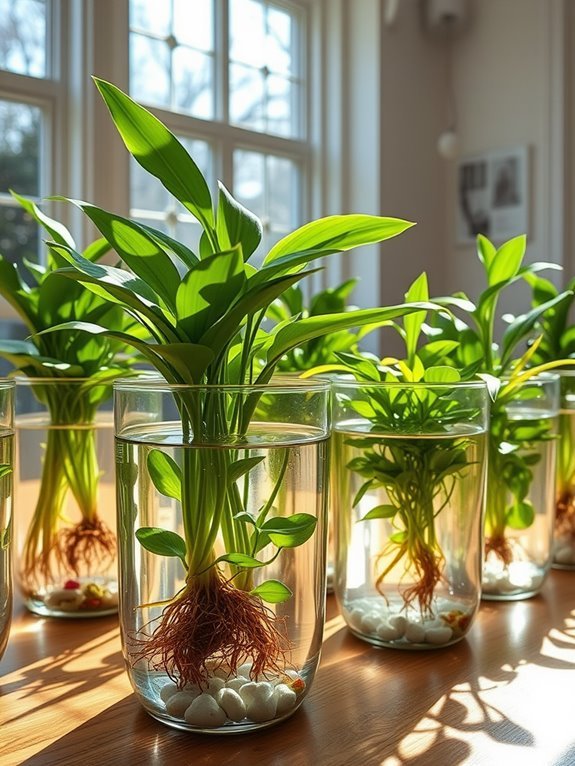
Understanding the specific needs of your indoor water plants is like deciphering a secret code that reveals their full potential. Each plant species has unique requirements, and knowing these can set you up for success. Immerse yourself in research and get to know your leafy companions!
- Identify whether your plant prefers bright light or shade.
- Learn how often it needs its water changed—some are picky!
- Discover the ideal temperature range to keep your plants happy.
Enjoy the Process of Caring for Your Plants
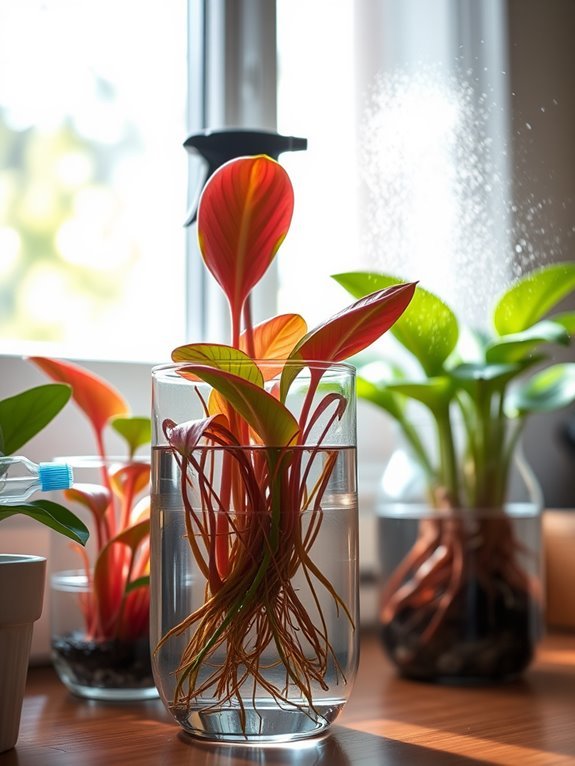
Caring for your indoor water plants can be a delightful journey, transforming your living space into a lush oasis.
You’ll find joy in watching them thrive, as they respond to your loving attention. Each day, you’ll discover something new—like a fresh leaf unfurling or tiny roots stretching out.
Plus, there’s nothing quite like the satisfaction of solving a little plant mystery, like why those leaves turned yellow.
So grab your watering can, put on some music, and let your plants know they’re part of the family.
Frequently Asked Questions
Can I Use Tap Water for My Indoor Plants?
Yes, you can use tap water for your indoor plants, but it’s best to let it sit for a day. This allows chlorine to evaporate, making it safer and more beneficial for your plants’ growth.
How Often Should I Check for Pests?
You should check for pests weekly, especially in warmer months. Regular inspections help you catch any issues early, ensuring your plants stay healthy. Don’t forget to inspect the undersides of leaves for hidden invaders!
What Signs Indicate My Plant Needs Repotting?
If your plant’s roots are bursting out of the pot like a wild beast, it’s time to repot! Also, if it’s stunted in growth or the soil’s drying out too quickly, don’t hesitate.
Are There Specific Plants That Thrive in Low Light?
Yes, several plants thrive in low light conditions. Consider snake plants, pothos, or ZZ plants. They’re hardy, require minimal care, and can brighten up your space without needing direct sunlight. You’ll love their resilience!
How Can I Increase Humidity for My Indoor Plants?
Imagine a gentle mist enveloping your plants. You can increase humidity by placing a humidifier nearby, misting leaves daily, or setting plants on a tray filled with water and pebbles. Your greenery will thrive!
Conclusion
Keeping your indoor water plants healthy is all about providing them with the right light, temperature, and care. With a little love, you’ll see them flourish.
Imagine lush greens basking in sunlight as you relax with a cup of tea in your indoor oasis. Gardening can be a delightful journey, transforming a task into a joyful experience.
So, roll up your sleeves, grab your watering can, and let the plant party begin! You’re ready for some green-thumb fun!
